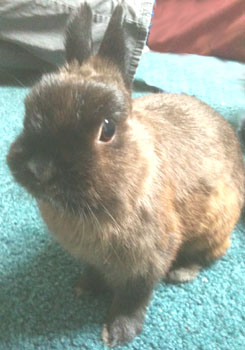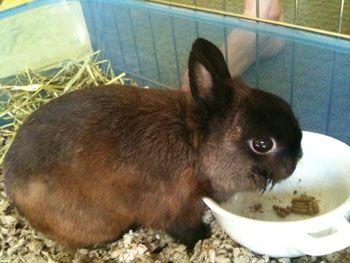Rabbits are social and cute, but require a gentle touch

Gulliver
photo by Dr. Lyssa Alexander
Having a rabbit is not like having a cat or a dog, but it can be just as rewarding. Rabbits are highly social animals. They can be kept singly or in small groups, but introductions must be done slowly and carefully.
They typically live 5-10 years (up to 15 in some cases). They are completely herbivorous. In nature they come up from their burrows to eat at dawn and dusk. At my house we call this “bunny o’clock.”
Housing:
Traditionally rabbits have been housed in hutches. However, most rabbits thrive in conditions that offer more opportunity for play and interaction. Indoor rabbits can be kept in large cages, penned areas or rooms. Most can be allowed to have wider access to the home under supervision for several hours per day. This is fun and stimulating for the rabbits and provides much needed exercise.
It is important that any area where they are allowed to roam is “bunny-proofed.” This means that any valuable objects are removed (one good chomp can do some serious damage) and all cords are blocked or covered. There are lots of cute videos on the internet of dogs and cats playing with rabbits, but don’t let these lull you into a false sense of security. Rabbits are prey. Even though they can get along in some circumstances, these interactions often end badly.
Minimum size requirements for housing are that the rabbit be able to stand up tall on his back legs and lay fully stretched out in all directions. They should have a litter box, hay and a water bottle at all times. Flooring should be completely solid because grates can cause serious injury to their feet.
Most rabbits can be litter box trained, especially if they are neutered. Keys for success are to place the litter box in the area where they prefer to use the bathroom and to offer them hay to munch on in their litter box (rabbits love to eat while they poop). The best type of litter is Carefresh or yesterday's news. Rabbits will typically make several dozen coco puff shaped fecal pellets per day and urinate frequently, so be prepared to change the litter at least every other day.
Toys are a great addition to any bunny home. They love to chew so cardboard boxes, untreated wicker baskets or solid wood parrot toys are excellent choices. They also love to hide in and under things, so feel free to get creative.
Behaviors:
During bunny o’clock, you are likely to see some fun bunny behaviors. They will often run rapidly from place to place with no apparent purpose. This is great exercise, and though it doesn’t make much sense, it’s fun to watch. They may also binky (I did not make this term up). Binky is a complicated kick into the air involving flinging the head back or to the side and wiping the body in strange directions. Some rabbits binky more often than others, but it is always a delight to watch.
Rabbits that are very relaxed will often kick their feet out to one side and stretch out. Rabbits may choose to sit on their owner’s laps or chests, but most rabbits prefer to interact by sitting nearby instead.
When you are first introducing a rabbit to your home, it is important to give them a few days to adapt to the sights and sounds on their own. Once you start interacting with them, sitting or laying on the floor (grab a book or a computer and settle in) is a great idea. After a while your rabbit will come over and check you out. Building trust and affection with a rabbit takes time, but can be very rewarding.
Handling:
Most rabbits do not like to be picked up. Also, their strong legs and long spines make it possible for them to actually break their backs by kicking out wildly or being improperly restrained. Despite this concern, it is important to get a rabbit used to being handled so that you can transport, examine and groom them. The hind end must always be supported. When picking up a rabbit stay close to the ground at first so that they can be released if they begin to struggle wildly. Keeping their eyes
covered or using a towel may help. Never pick a rabbit up by its ears (ouch).

Gulliver
photo by Dr. Lyssa Alexander
Diet: Water should be provided at all times from a dish or a hanging water bottle. Water should be changed daily. Some bunnies drink a lot, so make sure they have enough to last until it will be changed next.
Hay should be available all the time. Timothy hay is best. Orchard grass hay and brome hay are also good choices. Alfalfa hay was used for many years, but it can cause several different problems long-term including urinary stone formation and obesity. Bunnies can be offered a small amount of a low-calorie pellet every day as well (about ¼ cup per four pounds of body weight). Greens should be offered daily as well (1 cup per four pounds of body weight). Fruit and vegetable treats should be offered in very small amounts no more than once a day.
Acceptable greens: Red leaf, green leaf, escarole, endive, parsley, cilantro, carrot tops and beet greens. Avoid iceberg lettuce because it can cause diarrhea.
Acceptable treats: Slice of apple, banana chunk, carrot chunk, raisins or dried fruit.
Rabbits use bacteria in the cecum (part of the lower intestine) to convert indigestible plant material into nutrient-rich products. These products are called cecotropes. Cecotropes (also called “night feces”) are large, moist pellets that are eaten directly from the rear end. This usually happens during the night, and many owners are unaware that their rabbits do this. Cecotropes are extremely rich in
minerals, proteins and vitamins and are essential to a rabbit’s health.
Medical:
Rabbits should be spayed or neutered after they are 5 months old. In both sexes, this will significantly cut down on aggressive behavior. It can help profoundly with litter training as well. In females, uterine cancer is an extremely high risk that can be prevented with spaying. Rabbits do not require vaccination in the U.S., but they should be evaluated by a qualified veterinarian annually and have a fresh fecal sample checked for parasites.
Rabbits are a prey species, so they will often hide illness. For this reason, a visibly sick rabbit is probably much worse off than it seems. Common signs of illness in rabbits are heavy breathing, sneezing, discharge from the eyes or nose, not eating, decreased poop production, small or hard poops, tight abdomen, tooth grinding, drooling, bald patches, dribbling urine, bald sores on feet or unusual aggression. A rabbit that has not eaten or made much poop for over 12 hours is an emergency.
Rabbits are wonderful pets, but because of the care they need to thrive, think twice before purchasing one on a whim as an Easter present.
Dr. Lyssa Alexander treats small and exotic animals and pocket pets at All Creatures Animal Clinic.


Comments
A2K
Mon, Apr 25, 2011 : 12:31 p.m.
Excellent article! We got one of our awesome house-buns from a local rescue, and saved the other from a drafty garage where he'd been languishing *grrr, those people still make me MAD*. Two wonderful rabbit rescues we've utilized in the past (also great for info - to both experienced and new owners/adopters) Midwest Rabbit Rescue and Rehome <a href="http://www.rabbitrr.org/" rel='nofollow'>http://www.rabbitrr.org/</a> and Great Lake Rabbit Rescue (schedule a visit to see the Hoppy Hollow...cutest thing you'll ever see!) <a href="http://www.rabbitsanctuary.org/" rel='nofollow'>http://www.rabbitsanctuary.org/</a>
Emma B
Sun, Apr 24, 2011 : 11:11 p.m.
My sister took to showing rabbits at local fairs after our family adopted a rabbit that was left behind at one of them. My mother was initially told that they lived "about five years," so we certainly learned the hard way that a well-cared-for rabbit lives for at least 10 years! The rabbit we initially adopted lived for 13 years, and she saw seven companions come and go that all lived to be at least five. So I can confirm that anyone considering a rabbit should think twice and ignore anyone that tells you they only live a few years. You've probably heard that cockatiels and similar birds require large amounts of attention to remain happy-- I would say that, having had a cockatiel for about 15 years, that rabbits require almost the same amount to be genuinely happy. Especially if they have a smaller hutch/cage. It's harder to determine with some rabbits, but we had a couple that loved to binky all the time-- so they certainly would not have been happy cooped up all day in the cage. And you really do have to keep an eye on them, we had some nice wooden furniture that turned into chew toys when we weren't paying attention. All in all, if you're a parent considering a rabbit for your child, keep in mind how much time you'll be spending taking care of them! My sister started off having a lot of time to care for the rabbits, but when she entered high school and got involved in other things most of the caring fell to my parents for the remaining six or so years that we had rabbits.
Urban Sombrero
Sun, Apr 24, 2011 : 1:46 p.m.
Oh my gosh, that first picture is just way too cute! What a sweet looking little bunny.